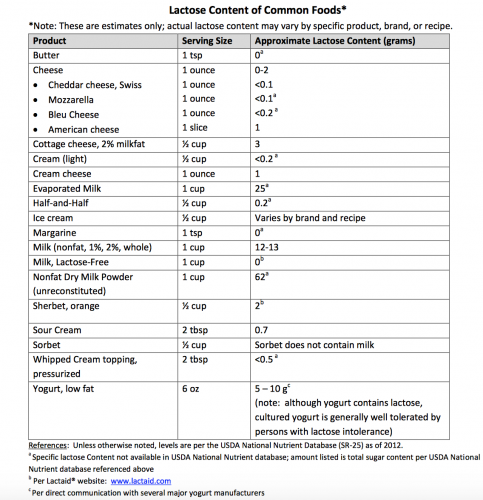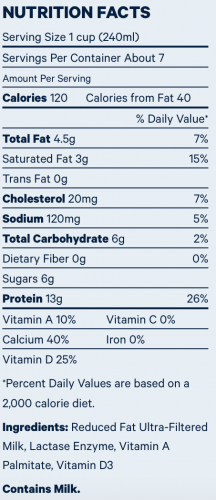This post was written by our former intern Jaclyn Schermer who was a dietetic intern from the Keene State College in New Hampshire.
Cramping, bloating, indigestion, and diarrhea after consuming dairy products. A person that is lactose intolerant can relate.
Rather than nix dairy completely, strategies exist to limit any condition-related symptoms. So what are the health risks associated with avoiding dairy, and what tips exist to make navigating the grocery store easier? Read on to find out.
Need a review on lactose intolerance? Review our blog post on the basics.
Cutting Dairy Completely: Negative Impacts on Health
Dairy provides nine essential nutrients–each with a unique role to help the body function properly. For instance:
- Protein: Repairs cells (and muscles!) and creates new ones, promotes proper growth in children, teens, and pregnant women.
- Calcium: Bone health, muscle and nerve function, and helps blood move easily through the body.
- Vitamin D: Helps absorb calcium and therefore improves bone health.
- Phosphorus: Works closely with calcium to promote healthy bones and teeth.
- Vitamin A: Teeth, vision, and skin health.
- Niacin, pantothenic acid, riboflavin, and vitamin B-12: Helps the body convert food into fuel (i.e., energy for the body).
By eliminating dairy, without accounting for the essential nutrients listed above, one could be negatively impacting their health. For instance, an increased risk of osteoporosis, bone fractures, heart disease, and overweight and obesity.
Enjoying Dairy: Two Ways to Reduce Lactose Intolerance-Related Symptoms
The next time you’re at the grocery store, look closely at dairy foods–and even your favorite non-dairy foods–to evaluate how much lactose or milk they contain.
1. Choose Dairy Products with Low Levels of Lactose
Rather than avoid nutrient-dense dairy, consider the level of lactose in a serving of dairy.

Note that lactose intolerance sits on a continuum, as some people may tolerate larger amounts of lactose in one sitting compared to another person. Or, the level of lactose that could be tolerated 10 years ago may differ now.
Even if a product is not obviously dairy, it may still contain dairy—either as an ingredient or due to potential cross contamination. Food and beverage packages will list ingredients, plus a list of common allergens that the product contains or may contain.

Some products may even spell out that the product is lactose-free, meaning that lactose has been removed, the lactase enzyme has been added to the product to digest the lactose, or the product never contained lactose. All three of these scenarios mean that someone with lactose intolerance can safely consume the product.
2. Look for Natural Sugars on the Nutrition Facts Panel
Labels can be very useful for determining if something contains lactose. For dairy products with few ingredients—like milk, cheese, and plain yogurt—the sugars listed are lactose, the natural sugar in dairy (see image to the right).
If you’re eating a flavored mango yogurt, the total sugars will include those from dairy and mango.
Remember that the numbers within a nutrition facts label are based on one serving (e.g., a single-serve container of yogurt). If you’re going to consume a larger portion, adjust the lactose number.
Updated August 14, 2017


